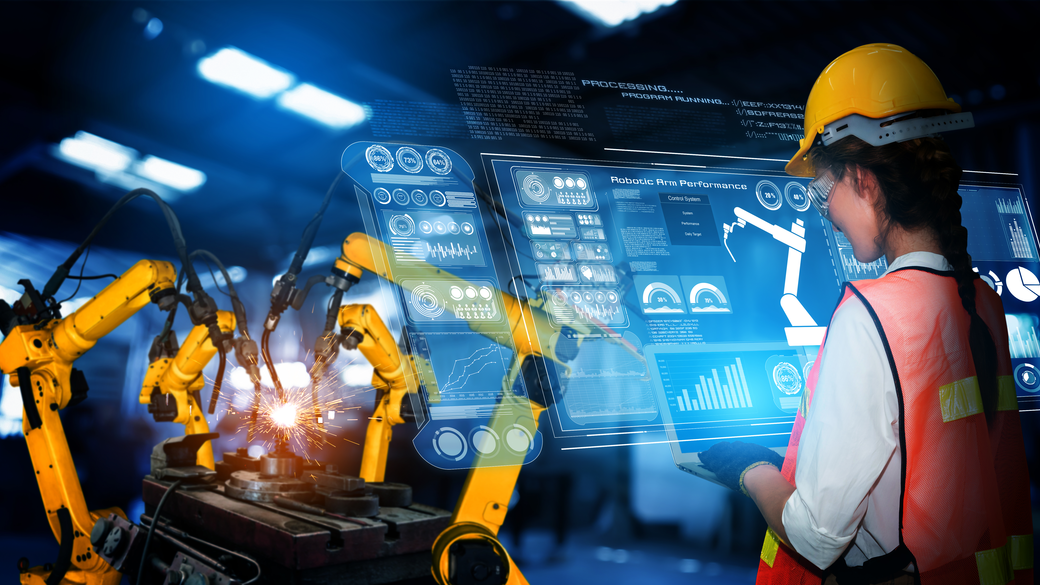
Smart factories leverage AI and connected devices to enhance efficiency, quality control, and worker safety.
While COVID-19 may be a fading memory for consumers, many businesses are still feeling the aftershocks. The pandemic exposed vulnerabilities in our global supply chain and other business processes, accelerating the need to shift gears to more agile and adaptable factory operations.
In addition to supply chain disruptions, businesses must contend with supersized customer expectations. Amazon has normalized free, next-day delivery and trained customers to expect the same service from companies everywhere. This exemplifies a type of anchoring bias known as the Amazon effect, where first-to-market companies set the standard.
The need for rapid-fire logistics and advances in artificial intelligence (AI) have helped drive demand for smart factories—factories with advanced technologies to automate processes for near-speed-of-Amazon efficiency.
Rockwell Automation's latest findings show that 95% of manufacturers are using or evaluating the use of smart manufacturing, up 12 points from 83% in just one year. And it's good news for workers: 94% of manufacturers expect to maintain or grow their workforce as a result of adopting smart manufacturing technologies.
A smart factory is a fully digitalized production facility that runs on smart technologies. This system includes interconnected devices and machines, which rely on AI, machine learning (ML), and big data to analyze and optimize production processes.
The continual flow of real-time data—to all equipment and workers—enhances product quality, productivity, and collaboration among teams of humans and of humans and robots.
Before explaining how a smart factory works, it's helpful to define a traditional factory as a reference point for comparison.
In a traditional factory, workers use automated machines like cameras, barcode scanners, sensors, digital manufacturing equipment, and clipboards to monitor production, inventory, and other plant processes. While some digital devices are in use, they are not interconnected. Data from various machines, scanners, departments, and personnel must be continually cobbled together for a big-picture view.
A smart factory, by contrast, integrates all people, processes, machines, and equipment into one digital ecosystem. The data is unified, accurate, and real-time so you can make smart, on-the-fly decisions.
Additionally, your smart factory is continually “training” the data. It can learn from experience as it’s exposed to more data and more events (i.e., equipment outages), becoming efficient at forecasting trends and future events.
An example of smart factory efficiency is automated quality control. Cameras and sensors on the assembly line continuously inspect goods, and if a flaw or defect is detected, the system will flag the item for removal.
In collaborative robotics, as another example, robots and humans work side by side. Robots may handle the literal heavy-lifting while workers focus on more complex tasks that require human oversight or a judgment call based on nuances and intricacies robots can’t appreciate. This approach enhances overall productivity and reduces physical strain on workers.
While most production plants are at the first level of their “smart” transformation, there are four different levels in how a smart factory is structured.
Beyond faster, data-backed decisions, smart factories provide many other outstanding benefits.
Smart factory technologies like cloud computing and connected devices are making it easier for U.S. manufacturers to bring back off-shore factory jobs. Many companies are motivated to do so. It increases supply chain oversight, minimizes dependence on international trading partners, and is popular with U.S. consumers.
From 2021 to 2023, the U.S. added nearly 800,000 manufacturing jobs to the economy, and in 2022, a record $108 billion was spent on new manufacturing construction.
Smart factories integrate IoT, AI, and machine learning to enhance productivity and efficiency. According to a Deloitte study, this could increase production capacity by up to 20% and reduce costs by up to 15%.
Smart factories optimize resources and minimize waste through real-time monitoring and advanced data insights. Companies can then more easily develop environmentally sustainable practices and comply with government regulations.
Cobots can improve factory safety by handling hazardous activities to reduce the risk of injury to human workers. Additionally, sensors and other devices can continually scan for and help mitigate safety risks.
Smart monitoring equipment delivers more consistent quality control, with increasing usage of digital twins to simulate and test products virtually and head off any real-world defects. This proactive approach improves product quality and consistency, and also reduces waste and production costs.
Smart factories can reduce operational costs through automation, predictive maintenance, and optimized resource management, reducing waste and inefficiency. Better inventory management and reduced lead times can further enhance cost efficiency.
Smart factories can automate routine tasks, allowing human workers to focus on more complex, non-repetitive roles and managing worker shortages. According to the U.S. Chamber of Commerce, the country has a major shortage of workers. The manufacturing industry lost 1.4 million employees during the pandemic and has not fully rebounded. As of January 2024, there was still a shortage of 622,000 workers.
Here are some of the technologies that fuel smart manufacturing.